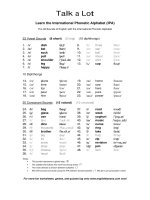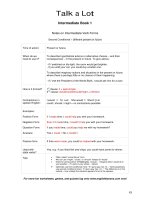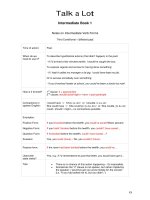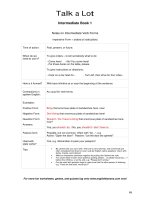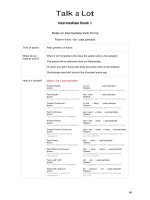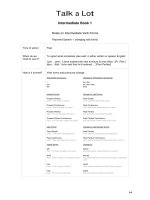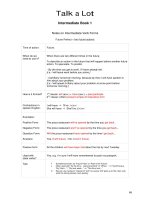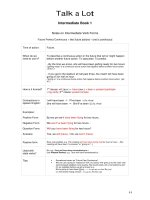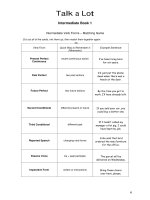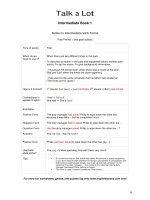talkalot intermediate book 1 future perfect continuous
Bạn đang xem bản rút gọn của tài liệu. Xem và tải ngay bản đầy đủ của tài liệu tại đây (478.79 KB, 1 trang )
Talk a Lot
Intermediate Book 1
Notes on Intermediate Verb Forms
Future Perfect Continuous = two future actions – one is continuous
Time of action:
Future.
When do we
need to use it?
To describe a continuous action in the future that will or might happen
before another future action. To speculate. To predict.
- By the time we arrive, she will have been getting ready for two hours.
[“getting ready” is a continuous future action that happens before another future action,
“arrive”.]
- If you get to the stadium at half past three, the match will have been
going on for half an hour.
[“going on” is a continuous future action that happens before another future action, “get
to”.]
How is it formed?
1st clause: will (aux.) + have (aux.) + been + present participle
(-ing verb); 2nd clause: present simple
Contractions in
spoken English:
I will have been Ö I’ll’ve been L]Kä]KîÄfåL=
She will have been Ö She’ll’ve been Lp]Kä]KîÄfåL=
Examples:
Positive Form:
By two pm we’ll have been flying for two hours.
Negative Form:
We won’t’ve been flying for two hours…
Question Form:
Will you have been flying for two hours?
Answers:
Yes, we will (have). / No, we won’t (have).
Passive form:
Rare, but possible, e.g. The meeting will have been being held for over an hour… [the
meeting will have been “in process” or “going on”…]
Used with
state verbs?
No, e.g. Terry will have been remembering to…
Use Present Perfect, e.g. Terry will have remembered to…
Tips:
•
•
Sometimes known as “Future Past Continuous”.
We can use “going to” instead of “will”, but using “will” gets us to the main verb
(and stressed syllable) more quickly. We would need a lot of contractions and
it’s six syllables before we get a stress! e.g.
We’re going to have been flying… = LïfKÖ]Kå]Kê]KîÄfåDÑä~fKàfÏL
or, this shorter slang version: LïfKÖ]Kå]KÄfåDÑä~fKàfÏL=
11
